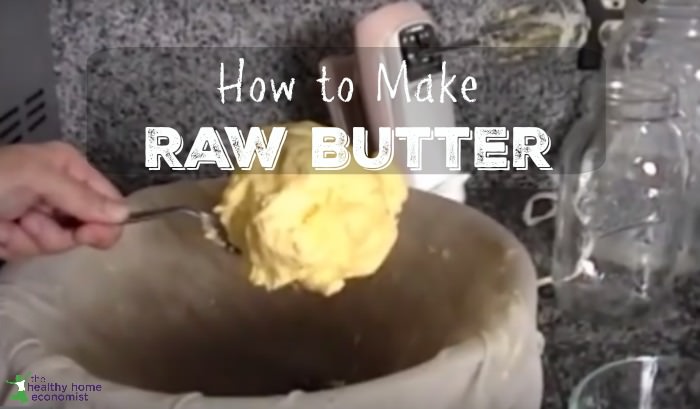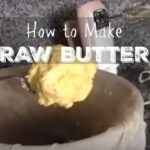Simple and easy recipe with video tutorial on how to make butter from raw or pasteurized cream to enjoy the ancestral health benefits of this nutrient-dense traditional food.

Ah, homemade butter. Has there ever been a more perfect food?
To the Traditional Swiss living in the isolated Loetschental valley early in the last century, raw butter made from unpasteurized cream was a sacred food. No pale supermarket butter, but a golden alpine butter made from the rich, beige raw cream of cows grazing on thick grass.
The children raised on this nutrient-dense, raw butter had strong physiques, and wide faces with plenty of room for their teeth. They also had high resistance to disease. There wasn’t a single case of TB in the Loetschental Valley despite this illness raging elsewhere in Switzerland during the early part of the 1900s. At that time, the Swiss villagers still existed on foods grown or sourced themselves in the valley. Only salt was brought in from the outside.
The young men raised on this nutrient-dense traditional diet with plenty of raw, deep yellow butter were so perfect and pleasing in physique, strength, and character that the Vatican favored them over all others in Europe to serve as the Papal Guard.
The Loetschental Swiss knew that it was this nutrient-dense, raw butter that was responsible for their robust health. The indigenous Swiss would put wicks in bowls of the first spring butter and burn it in their Churches!
We now know that this sacred food contained ample amounts of true Vitamin A, D, and K2. When sufficient amounts of these fat-soluble vitamins are present in the diet, they work synergistically to produce a level of health unknown in modern civilization.
The Importance of Raw Butter in the Diet
When I first became knowledgeable on the subject of Traditional Diets, obtaining plenty of raw, grass-fed butter for my family became a primary goal.
The problem was that raw butter was not available anywhere near where I lived. I couldn’t even find raw cream or unpasteurized milk for that matter!
Determined to have this sacred food for my husband and me (I was pregnant at the time) and for my oldest child who was a young toddler, I sourced quarts of frozen, raw grass-fed cream from elsewhere and shipped in 9 or more quarts a month for my family’s use.
With some of that beautiful beige, grass-fed cream, I would make the most tantalizing, golden butter for my family. I continued this habit for many years.
I am fortunate that now I am able to obtain raw, grass-fed butter locally so I rarely have to make my own raw butter anymore. However, I thought it would be helpful to show you how to make this sacred food for yourself in case some of you are in the same predicament that I was many years ago – desperately wanting raw, grass-fed butter but unable to find any!
How to Source Grassfed Cream
The only thing you really need when making butter is quality pastured cream. Don’t use anything else or your butter will turn out white or at best pale yellow. A light-colored butter indicates a low amount of fat-soluble vitamins.
The easiest route is to buy quarts of raw, grass-fed cream from a local farm. If you don’t have a local grass-based dairy farm nearby, you can request your local health food store to stock a pasteurized cream.
Natural by Nature is a good brand as is this pastured A2 cream.
This brand of Devon cream is excellent too and can be mail-ordered to your door.
Be sure to avoid UHT pasteurized cream by Organic Valley as it is too overly processed.
If you can obtain raw, pastured milk but not cream, you could also take the cream off the top of a gallon or two of the milk using a turkey baster and make butter with that cream.
The key is to get creative!
Don’t take no for an answer if you can’t find quality cream where you live. Figure out where to get it whether it be sucked off the top of a few gallons of grass-fed milk or shipped in from another place. A great way to find farms that will mail order cream to you can be found in the Weston A. Price Foundation Shopping Guide.
Can’t Tolerate Butter?
If due to allergy or availability, you are unable to enjoy the benefits of pastured raw butter on a regular basis, it is very important to be sure you’re getting sufficient Vitamin K2 (called the “X-Factor” by Dr. Price) in the diet via a whole food derived K2 supplement (as MK-7, the fermented form). Another dairy-free option to obtain K2 (as MK-4, the animal form) is Australian emu oil.
Both forms of Vitamin K2 synergize with Vitamin A and D obtained in the diet and/or via high vitamin cod liver oil for maximum absorption and effectiveness. The three together are particularly effective at maintaining the health of the teeth and gums.
Homemade Butter
The recipe below details the instructions demonstrated in the video tutorial. You may use either raw or pasteurized cream, preferably from pastured animals.
Note that once you make the butter, you can easily take it one more step to make homemade ghee, which is shelf-stable. Both ghee and raw butter oil are concentrated forms of all the goodness of butter!

How to Make Butter
Recipe for homemade butter using pasteurized or raw cream. Super easy and when sourced from pastured cows, is one of the healthiest foods on the planet.
Ingredients
- 1 quart cream preferably raw and grassfed
- 1 large glass bowl
- 1 hand mixer
Instructions
-
Pour cream into the bowl and let come to room temperature.
-
Turn on hand mixer on medium speed and mix until the cream turns into butter. You will know this because suddenly, the butter will separate from the buttermilk in the bowl and change color to yellow. This takes about 3 minutes.
-
Add 2 cups ice cold water and remix for a few seconds. Pour butter mixture into a fine mesh cheesecloth, gather up the ends and squeeze bag to strain out the water mixed with buttermilk. Repeat this rinsing process one or two more times as desired to make sure all the buttermilk is removed for the sweetest tasting butter.
-
Scoop the butter into a small container with a lid. Refrigerate.
Recipe Video
Recipe Notes
If you use slightly soured cream in this recipe instead of fresh cream, you will have cultured butter!
Reference
Nutrition and Physical Degeneration, Dr. Weston A. Price








Hi Sarah,
When we click on the link to the Devon Cream brand you recommend, it takes us to Bird’s custard mix on Amazon. What brand of Devon Cream do you recommend?
You must be in another country besides the US. The link is working correctly on my end. The brand is Devon Cream.
I’m torn between making kefir and drinking raw milk on the one hand or making butter or even cheese on the other hand. I’m looking for the biggest bang for the buck in terms of nutrition and gaining weight / muscle. I can understand how cheese is irreplaceable because it usually requires aging and so it makes sense that it would have unique characteristics nutritionally (some say it’s extremely detoxifying ect…) but butter is such a simple and relatively quick process. So I’m curious, would you not get all and even more nutrients from just drinking the raw milk? Does the process of making (uncultured) butter increase the vitamins somehow? It doesn’t seem like making butter or cheese is at all cost effective if the goal is maximizing nutrition and calories. Lately I’ve been blending a smoothie of raw eggs, 2nd ferment kefir, raw milk, raw honey and some fruit for super dense calories/nutrition. Your site is awesome! I’ve spent like two days now going through and bookmarking things. Tomorrow I will make the no bake cheesecake with granola crust. Thank you so much.
This worked perfectly! Had some leftover “starting to sour” raw cream, didn’t want to waste it so decided to make butter! Took about 10 minutes of mixing but it worked. Added some pink salt, then did the ice wash 3x. Tastes so good! Can’t wait to eat tomorrow once chilled. Never buying grass fed butter again! Plus it has no sneaky bad oils added in like some store bought brands.
Hi Sarah, I live in the same area as you. . In your article you mentioned of purchasing raw butter locally. Would it be possible to share that information with me. I to have been using Kerrygold but want a more quality product and already purchase a quite a bit of food from local sources. Thanks in advance
There is no raw butter anywhere currently in my location that I know of due to the run on raw milk from COVID-19. You will have to make it from cream.
I made this recently and it was great, but turned blue/gray within about four days. I had to throw it out. How long does it typically last?
The raw butter I’ve made lasts for weeks. Not sure what happened to yours … perhaps the cream was old?
if you use raw grassfed milk as your source for cream, what do you do with the left over milk that is basically skim milk?
Not many uses for it unfortunately. You can make it into yogurt.
Will, I just tried it for the first time with 16 oz of grass fed cream and it worked perfect. I poured the cream in a bowl which I sat in another bowl of ice. I beat it on high until past the whip cream stage and it started getting finely chunky and I saw a little liquid on bottom of bowl. Then I poured about a cup of icy cold water (I put in my freezer for a while) and beat that in. Then poured all in my nut milk bag and squeezed liquid out. Beautiful firm yellow butter resulted. We drank the liquid … not wasting it because 16 oz of raw cream costs $13.95 where I’m from, yikes. Hope this helps.
I believe it has to be non-homogenized and, if possible, raw or low temp pasteurized. I hope this helps ease your mind.
Please help! I cannot seem to make butter. I use 100% grassfed cream. I’ve tried with fermented cream and regular. The cream is VERY thick (you cant pour it). It just blends down to the whipped cream stage, then turns to liquid and just stays liquid. I’ve literally done this about twenty times and it is the same result. I can take creme fraiche from the supermaket and it makes butter in minutes but the good grassfed cream just won’t happen. Please help as this is driving me crazy!!